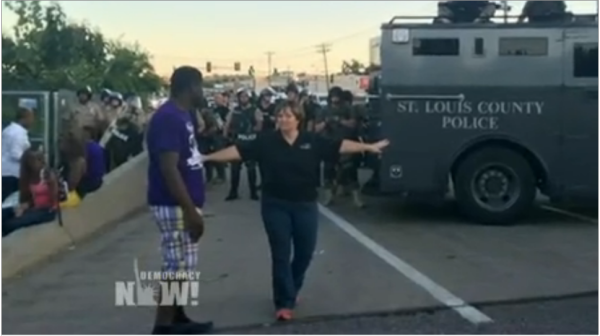This is a rush transcript. Copy may not be in its final form.
AMY GOODMAN: Radley Balko is the author of the book Rise of the Warrior Cop: The Militarization of America’s Police Forces. He also blogs for The Washington Post. He’s speaking to us from Nashville. Talk about the level of militarization of this police department, what you saw as you watched the police for the first days of these protests.
RADLEY BALKO: Well, I mean, I think what we saw was a manifestation of a trend that’s been going on for 30 to 35 years. You know, it seemed particularly bad in Ferguson, but a lot of what we saw in Ferguson was the St. Louis County Police Department sending in their SWAT teams and tactical teams to, I guess what they would call, preserve order in Ferguson. You know, this has been happening, as I said, since about the early 1980s. The transfers from the Pentagon of surplus military equipment—we’re talking tanks, armored personnel carriers, grenade launchers, helicopters—that began early in the Reagan administration informally and then was formalized by Congress in the 1990s. We’ve had millions—literally millions of pieces of military equipment have been exchanged this way. And then, after September 11th, the Department of Homeland Security started sending out checks to buy new military-grade equipment from companies that have now sprung up to build that equipment. So, you know, this—what we’re seeing in Ferguson, this is not a local issue, really. I mean, this is something that’s been driven by national policies, by policies that Congress has approved of and has oversight of, and could end tomorrow, if they wanted to.
JUAN GONZÁLEZ: And, Radley Balko, I mean, I was struck not only by the assault weapons and the armored vehicles, but even by the officers changing their uniforms into military fatigues, as if they were going to war, rather than they were actually policing largely angry peaceful protests. There were some—there was some looting, and there was some rock throwing and possible Molotov cocktails, but it really was not on a major scale, from everything that I could tell. But yet they were loaded for war.
RADLEY BALKO: Right, and I think that, you know, there are the obvious problems when we see the weapons, but the uniforms matter. When police officers are wearing camouflage, it sends a very clear message to the community that they’re supposed to be serving. It also affects the mindset of the police officer himself. You know, the idea that when we take domestic police officers and we train them like soldiers and we give them military gear and we dress them up like soldiers and we tell them they’re fighting a war—you know, war on crime or war on terror—they’re going to start to see themselves as soldiers. And that’s just a mindset that’s not—that really isn’t appropriate for domestic policing. And I think you saw that in the way that they responded to protests—not just in Ferguson, but also, you know, a lot of the crackdowns on the Occupy protesters, on the crackdowns at the political conventions over the years. I mean, this has become our default response to protest in the U.S., and it’s something that, you know, I think could be very antagonistic toward the very idea of free speech and the First Amendment.
Read the Full Transcript in Democracy Now!










